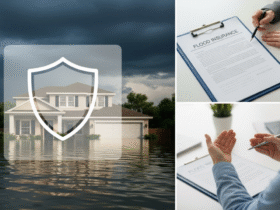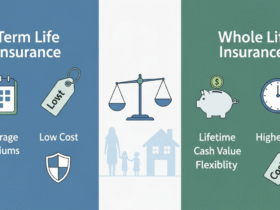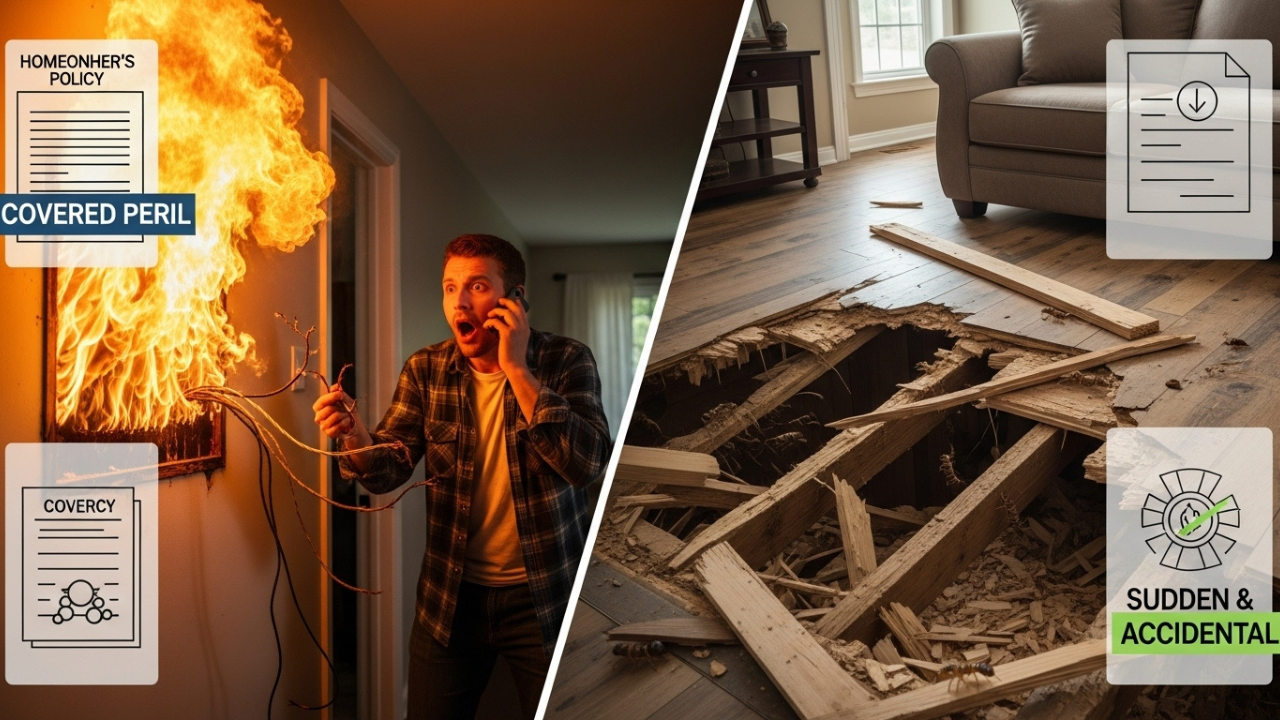If you are a homeowner, you understand that there are lots of things to manage, from the routine maintenance work to the demanding upkeep. But, apart from everything else, discovering Termites has invaded your house undoubtedly one of the most common phobias for a house owner. Termites are dangerous pests because they can create significant structural damage. So when the financial burden surmounts, the question that most people raise is whether homeowners insurance cover termite damage?
I am sure many people would vehemently agree with the pondering statement. It is indeed one of those questions which needs coverage and through explanation . This article is dedicated to providing not just a yes or no, but rather a comprehensive outline of insurance assistance alongside many safeguards for your home that can be taken before they infest your property and prove to be financially taxing.
Let’s begin:
Key Takeaways
- Most homeowners insurance policies do not cover termite damage.
- Insurance only covers termite damage if the infested house suffers another covered peril such as fire or collapse.
- As a diligent homeowner, preventing termite damage is entirely your responsibility.
- Standalone termite protection policies can be obtained from pest control companies.
- Conducting early detection coupled with regular inspections can save one thousands in repairs.
Understanding the Basics of Homeowners Insurance
Before delving into termites, let’s first examine how homeowners’ insurance works. Homeowners’ insurance is meant to protect your home from potential damage caused by fires, windstorms, hail damage, or certain types of water damage. If the damages are unintentional and occur suddenly, the insurance will help to cover repair or reconstruction costs.
There is, however, a limitation: insurance usually does not cover maintenance problems that are the result of gradual deterioration. That difference is important in understanding termite damage is typically excluded from coverage.
So, Does Homeowners Insurance Cover Termite Damage?
Generally speaking, the answer is no. Termite damage is classified under preventable damages and thus does not fall under homeowners’ insurance coverage. Unlike sudden breakdowns of machinery, termite infestations are a process that build up over time. Since termites infestations are preventable as part of regular maintenance, insurance companies deem it the homeowner’s burden and not an insurable occurrence.
Their point of view makes perfect sense. You are expected to maintain your plumbing in such a way that a major flood does not happen. In a more minor example related to roofing, a breach in the roof is expected to be sealed and kept off from the elements in order to protect the house from flooding.
For this reason, insurance companies expect every homeowner keeps any pest infestations such as termites away from their property, and if left unchecked and those termites cause damage, the result is viewed as negligence rather than an unprotected fall.
The explanation may sound infuriating; however, insurance companies draw clear lines defining what can be protected against and what cannot. The causation of damages through termites, without a doubt, falls under the protected side.
Are There Any Exceptions?
While it’s most often the case that damage caused by termites is not covered, there are some unusual instances where your coverage may assist:
1. Termite Damage That Leads to a Covered Peril
Assume, for example, that termites chew through electrical wiring located within your walls, which leads to a fire. Almost all homeowners insurance policies cover fire as a peril. Therefore, while the termite infestation wouldn’t be covered, the damages resulting from the fire could be.
This type of situation can be tricky, however. The damage (fire) sustained is covered, even if part of the reasoning for the damage (termites) is not. Regardless, there is a good chance you’ll have to justify that you had no knowledge of the infestation, and it was unexpected.
2. Sudden and Accidental Collapse
Your policy might cover structural damage to your home in the highly unlikely event that a portion of your building suffers a sudden collapse due to the activity of termites, such as giving out floors and walls falling apart. The catch is this; “sudden and accidental” is a legal term in insurance and you will need to justify the collapse as unwitnessed, uninvited, and unclaimed neglect of time.
Most of the time, claims are denied without very clear documentation and expert testimony. That is why this exception exists in theory, but in practice it is rarely approved.
Why Insurance Views Termites Differently
Think of the nature of how damage occurs to understand why termite damage is not covered. Fires, storms, or even pipes bursting have a moment in time when they happen. Insurance companies can pinpoint a cause and determine liability.
However, termite damage is not like that. With termites, the damage is incremental, and you may not notice anything for months or even years. By the time you realize something is wrong, so much time has passed that serious damage has already happened. Insurers view this as maintenance over time expense and not something they need to pay for.
Similar to mold, rot or rust, all of these are often excluded unless directly resulting from a covered event.
What Does That Mean for You?
If you are a homeowner, this means you are liable for termite prevention. While this may not be the best news, it is better to accept this now rather than later after discovering extensive damage, thinking your insurance would cover it.
What are the available options? Take preventive action, plan ahead, adjust the controls and even look into added coverages that are not typically included in homeowners policies.
How to Protect Your Home from Termites
At this point you should be able to focus on what you can control. Mitigating termite damage is largely an exercise in being proactive. The good news is that many of these measures are time honored, part of regular maintenance, and low cost.
1. Schedule Regular Inspections
Termite inspection should be done at least annually. For those living southwestern U.S., California, and other warm, humid areas, every six months would be a better frequency.
Your licensed pest control operator knows what he is doing. They know what signs to look for such as wood damage, mud tubes, or droppings.
2. Eliminate Moisture Problems
In addition to water damaged wood, termites are attracted to leaky pipes, poor drainage, and humidity. Clogged gutters and downspouts as well as plumbing leaks can also make your home more appealing to termites and should be fixed immediately.
3. Keep Wood and Soil Separate
Avoid allowing firewood or any wooden objects to contact flora a few feet from your foundation. Firewood, planters, and wood mulch should also be kept a few feet away as these serve as food for termites which burrow underground and travel through soil to reach wood..
4. Seal Entry Points
Inspect the foundation of your house, and windows and doors for any aligned gaps, cracks, seams. Using caulk to close these gaps will curb entry for termites as well as other nuisances.
What to Do If You Already Have Termite Damage
In the case that you discover possible termite infestation, it is best to call a pest control specialist as soon as the outbreak is identified. While quiet, only a small portion of the house is damaged, that number increases as time pass.
Step 1: Call a Professional
Immediately, contact a pest control company that has an active license. They can confirm the existence of termite infestation and provide insight on possible solutions.
Step 2: Ask for a Full Damage Assessment
Knowing damage details is essential. Certain pest control services will diagnose and provide a detailed repair method while others would refer a structural repair contractor they trust and work with.
Step 3: Review Your Insurance Policy
Even if your insurance doesn’t cover termite damage, it is worth reviewing your policy. Check for mention of “pests,” “vermin,” or “insects.” Any ambiguous terms noted would warrant a call to your insurance agent for further explanation.
Can You Buy Separate Termite Protection?
Absolutely. Homeowners insurance does not cover termite damages, but numerous pest control firms have termite protection plans available. The coverage generally includes:
- Regular inspections
- Preventive measures
- Damage repair guarantees (in some instances)
Depending on the firm and its location, these plans could range from several hundred dollars to over a thousand annually. It is an added expense, but for homes located in high termite activity regions, the savings on repair expenses can be substantial.
Some companies go as far as offering termite bonds, which are contracts that guarantee servicing for termites including prevention but also warranty repairs for any damage that would occur afterward during the contract period.
My Opinion| Does Homeowners Insurance Cover Termite Damage?
From your perspective, home damage resulting from termite infestations is likely covered by your homeowners insurance policy titled “homeowners insurance.” However, as this guide makes clear, the coverage is excluded in most situations, with homeowners insurance covering termite damage.
This is an issue that many homeowners face ó feeling as though the insurance not only covers the property but also augments its value.
In fact, the insurance company is likely to deem such damage as part of routine maintenance, meaning that the responsibility is on you to maintain the structure through landscape inspections and moisture control systems, alongside meticulous landscaping. The onus is cornered squarely on the owner’s shoulders.
There’s still promise. With proactive measures, remaining vigilant for termite warning signals, and understanding the intricacies of your insurance policy, you can sidestep the financial ruin an overwhelming infestation brings.
Take action now. For those sensitive to procrastinating, check your insurance policy so questions regarding on-coverage and off-coverage can be ascertained along with optional add-ons. What remains undisclosed will only worsen post damage discovery.





























Leave a Reply